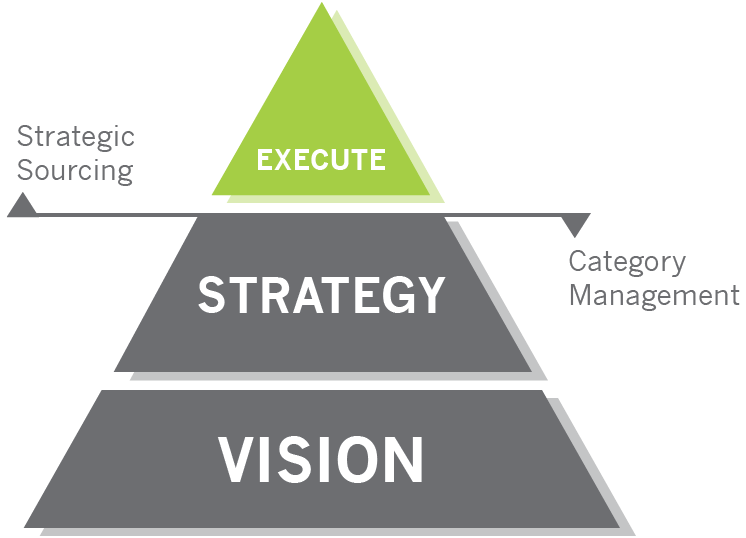Is Your Procurement Organization Really Conducting Category Management?
Diving into Nitor Partners' second element, Category Management, we would like you to consider your Procurement organization and ask yourself the question: "Is it really conducting Category Management?" This article will pose significant questions for your Procurement team and get to the root of what effective Category Management t should look like and how it is critical to success.
t should look like and how it is critical to success.
So, are you managing your categories effectively or are you only appearing to do so? Are you an impostor when it comes to Category Management, or are you the real deal?
Regardless of what you think the initial answer to that question is, take a closer look at the common mistakes companies make, while under the impression they are conducting Category Management across their organization.You may be surprised to learn that Category Management is NOT about:
- Running projects to reduce costs or improve quality, delivery and service. In fact, this is conducted through our third Element - Strategic Sourcing (more on that in our next blog!)
- Managing the risk, performance, and relationship with Suppliers. That is addressed in our fifth Element - Supplier Management.
Below is a list of sanity checks to use while looking at your organization to determine if you are truly conducting effective Category Management, or if it's time to remove the thinly veiled disguise:
- Do you have a robust category hierarchy/taxonomy across the company that enables insight into natural sub-category, supplier overlap and item level descriptions? Does this category hierarchy aid in identifying all opportunities within a category?
- Have you segmented all the categories into critical, strategic, leverage and transactional to enable focus on the key areas?
- Have you developed a process and cadence with business stakeholders to facilitate active engagement in developing a joint vision and strategy for key categories?
- Do you understand the existing pain points within the category, current supply base, and the needs of the business?
- Do you truly understand the market dynamics of the key categories or only your company's specific and historic approach to the market?
- Are you conducting Strategic Sourcing projects in a reactive manner rather than proactively understanding the real priorities of the business needs?
- Does it often feel like there are other Strategic Sourcing projects competing for the same internal resources? Do projects take longer than expected and/or not realize the estimated value?
- Within your eSourcing solution, are your Category Management plans tied to the specific portfolio of projects identified to execute the vision and strategy for the category?
- Are the resources in your organization trained in Category Management?
If your company can identify with any of the above pain points, unfortunately, we must diagnose you as a Category Management impostor! However, the good news is, you are not alone.
Historically, most companies were ill advised and have missed this step in their processes. It was common to go right from our first Element, Spend Analysis straight to the then "trendy" Strategic Sourcing. Companies are now beginning to realize the true importance of Category Management. In fact, Category Management is the new "buzz" phrase replacing Strategic Sourcing as the "must-do activity" to generate value.
You can take off the disguise for good and move towards being best in class by viewing your upstream process and value creation in a different way:
- Look at Category Management and Strategic Sourcing as two separate but related processes. Category Management is about building relationships with the business around key categories to help shape a multi-year vision and plan for the entire category. Together, the business and Procurement can identify a portfolio of projects to be executed using the Strategic Sourcing process. Strategic Sourcing, on the other hand, is the six-sigma execution of the projects identified in the Category Management process. Think of Category Management as the parent and Strategic Sourcing as its child.
- Prepare to spend the time and energy with the business stakeholders creating the larger vision and strategy for key categories. Do not only look to reduce costs. Consider what you want the category to look like in one, two, or even three years. Unlike Strategic Sourcing, this work is conducted in a non-project/time bound environment and enables creative thinking and planning. This process allows a Procurement organization to showcase its true value proposition. Be a trusted adviser to the business and shape categories in a proactive, rather than reactive, way.
- Once you have the vision and strategic plan, then, and only then, should you start moving forward with the specific Strategic Sourcing projects. The value derived from these projects will be higher and it will be achieved in a more efficient and integrated manner. Gone will be the days where Strategic Sourcing projects were a reactive approach to try and reduce costs and a desperate attempt to find value to report to the business.

Transformation and change are always challenging. However, addressing the approach to Category Management is one of the best things your Procurement organization can do to significantly improve the value it creates. The Nitor Category Management process, tools and methodology will help you develop a category vision and strategy through the six following steps:
- Stakeholder Engagement: Identify the stakeholders within a category to determine their level of support and influence - drive for active and open engagement. Establish the objectives of the Category Management approach.
- Category Mapping: Mapping the category and subcategories (spend, suppliers, geography, stakeholders, business requirements) provides a deeper understanding of the category spend within the organization and insight into potential opportunities. The information gathered in Element 1 - Spend Analysis will help complete this part of the process.
- Performance Review: Assess performance of the existing suppliers against the business requirements and determine areas for improvement.
- Market Assessment: Develop a comprehensive view of the broader market for the category including key suppliers, market share, risks, opportunities and capacity. Assessing the market dynamics of the category provides insights into how your organization is positioned in the market.
- Strategic Review: Use strategic tools, outputs from the earlier steps of the process, and stakeholder input to determine the multi-year vision and strategy for the category. After that, you can identify clear priorities to implement.
- Project Portfolio: The end result of the Category Management process is a prioritized portfolio of projects (based on value, complexity, effort, time and risk) to be executed to implement the category strategy.
Our first element, Spend Analysis, provides the data used to start the Category Management process (see previous blog for details on how to improve Spend Analysis). Once you have completed the Category Management process and identified the vision, strategy and project portfolio, you can look to the next step, Strategic Sourcing, to start executing the identified projects and deliver value for the organization.
Be sure to check out our next blog in our 8-Element series and learn how to turn a newly designed category vision and strategy into hard dollar savings, while also improving quality, service and delivery. www.nitorpartners.com
| Molly Wilson | |
| Analyst |
{{cta('b5a69d54-0671-4cae-8749-203341234ac0')}}
